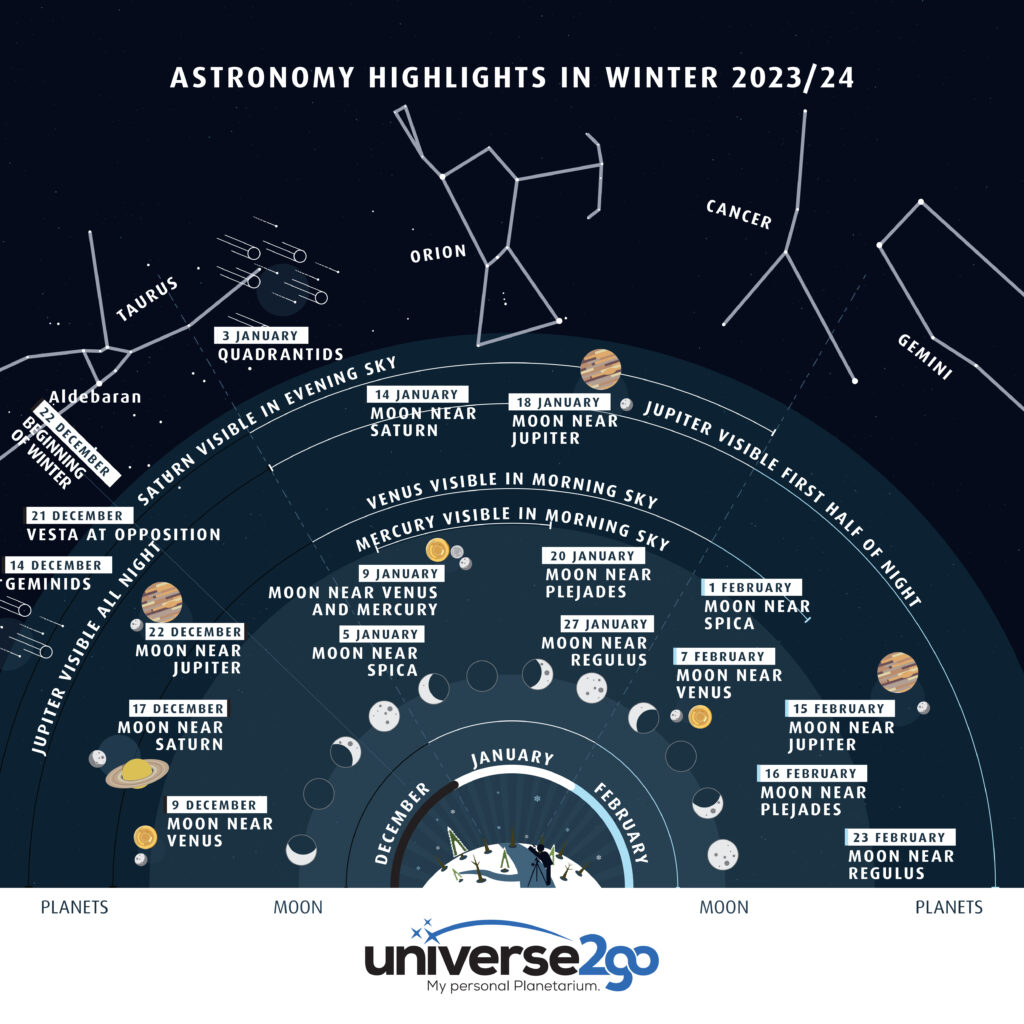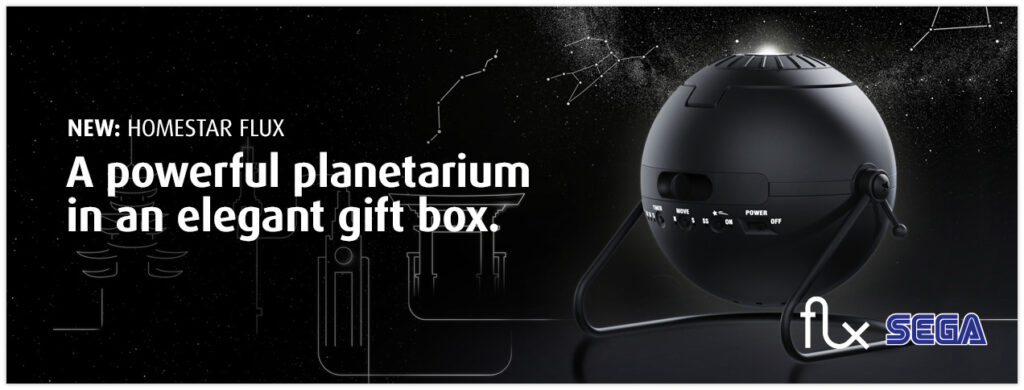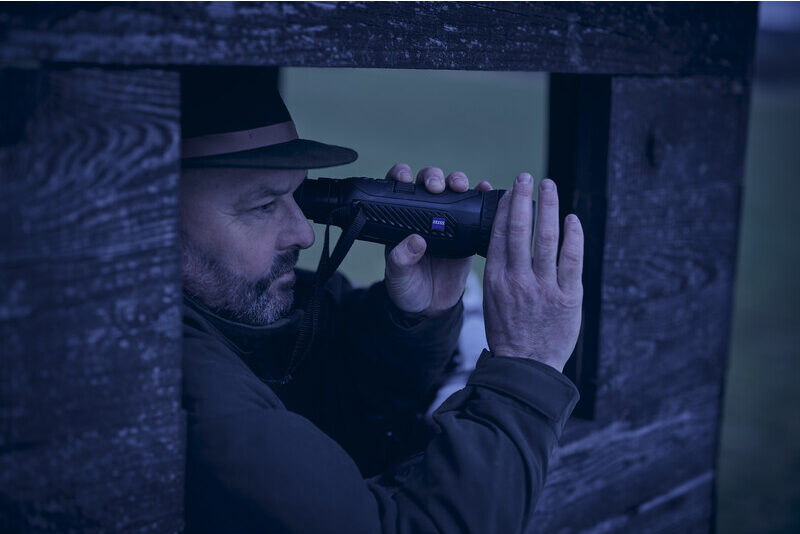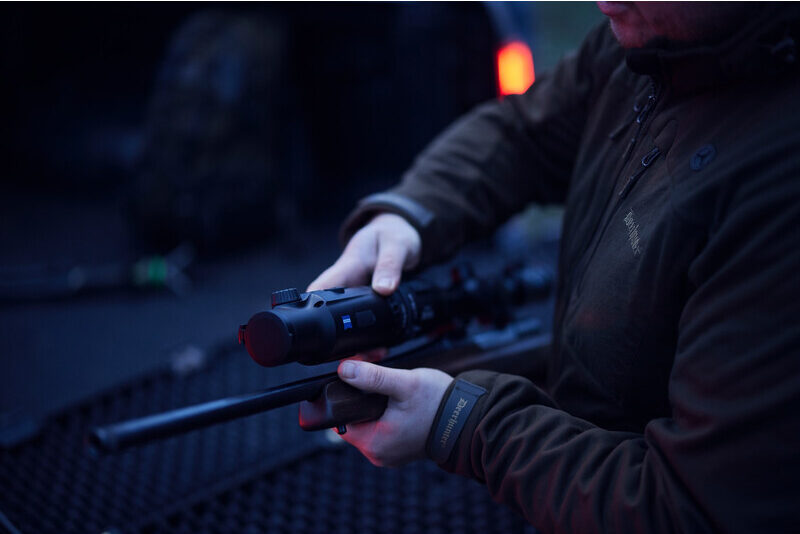The Winter of 2023 gives us some exciting astronomical events that should not be missed. Among these is the Geminid meteor shower that is best to behold under a dark sky, good visibility of a dwarf planet, or interesting interactions between the delicate crescent Moon and the planets. Even cold weather cannot stop us from taking a look at the night sky. One thing we know for sure: It will be fantastic!
This infographic shows you astronomical events for the upcoming months of December, January and February.
You will find accompanying texts below the graphic. Enjoy the observations!

Events in December 2023:
December 9: Moon meets Venus
On December 9 there will be a meeting between the Moon and the bright Venus. This encounter takes place in the early morning hours before sunrise. Both celestial bodies are visible on a horizontal plane. The Moon appears as a thin crescent disk, illuminated only by 14%.
December 14: Geminids
A beautiful astronomical event this month is the Geminid meteor shower. It is a meteor stream that can be seen in the night sky every December. The Geminids are named after the constellation Gemini, from which they appear to come. This year the peak of the meteor shower is expected to be reached in the night of December 13-14, so right in the middle of the month.
December 17: Moon meets Saturn
The thin, but growing Moon meets the planet Saturn on the night of December 17. Compared to its opposition in August 2023, its apparent diameter is much smaller, measuring only 16 arcseconds. Nevertheless, observing it through a telescope is always an impressive experience, especially for beginners. The ringed planet is hard to be missed in its splendor, even though being outside of its best observation period.
December 21: Vesta in opposition
Dwarf planets lead an inconspicious “life”, as they usually stand in the shadow of their larger and more radiant siblings, the planets. Nevertheless, they belong to the extended family of the Solar System. Their observation may not be as spectacular, but on December 21 there is an interesting exception: The dwarf planet Vesta is in opposition and reaches a brightness of 6.4 mag. You can easily find Vesta with binoculars in the Orion region. It is important to use a star chart for this beautiful astronomical event, so that you don’t mistake Vesta for a star.
December 22: Moon meets Jupiter
Tonight the Moon approaches the planet Jupiter and passes by at a distance of only 2.5 degrees. Throughout the night both celestial bodies move away from each other. Therefore, we recommend starting the observation at the beginning of dawn.
Events in January 2024:
January 3: Quadrantids
Not only August offers meteor streams, also January has impressive astronomical events to see. The “Quadrantids” are a meteor shower that appears to come from the constellation of Bootes. In the night of January 3 it reaches its maximum and theoretically you can see up to 120 meteors per hour. However, this is a theoretical value that is significantly smaller in practice. Nevertheless, this astro event is a wonderful experience.
January 5: Moon meets Spica
In January the Winter constellations dominate the sky and shine brightly above our heads. The star Spica reminds us more of Spring, but that is still a while away. Therefore, we have to wait a few more hours, because Spica and the crescent Moon only appear in the middle of the second half of the night above the horizon.
January 9: Moon meets Venus and Mercury
Clear sky and a visible horizon? Then take advantage of the dawn for a quick observation or a mood photo. In the Southeast the two inner planets Mercury and Venus are united with the thin crescent Moon. With or even without any equipment, every stargazer should take advantage of this opportunity.
January 14: Moon meets Saturn
A 3.5-day-old crescent Moon and a clear horizon – always a beautiful sight. But what do we discover nearby? Saturn. The ringed planet is about 3 degrees westward and shines with a brightness comparable to the brightest stars in the sky. How about an observation session of the world of Deep-Sky objects after the Moon has set? The weekend is definitely a good time for that.
January 18: Moon meets Jupiter
The path called the Ecliptic takes the Moon past the planet Jupiter, the brightest celestial body in the current sky, surpassed only by the Moon. Both objects are currently located in Aries. The constellation is rather inconspicious, as it consists of only four rather faint stars.
January 20: Moon meets Pleiades
A few days after the Half-Moon, the Moon meets the Pleiades – the famous Seven Sisters. They have always played an important role in antiquity and in mythology. It is the most prominent open star cluster that we can perceive with the naked eye. It consists of several hundred up to 1000 stars and is located at a distance of about 400 light-years. On photos the Pleiades are surrounded by blueish reflection nebulae, which give them a particularly aesthetic appearance.
January 27: Moon meets Regulus
On January 27 the Moon meets the star Regulus in the constellation of Leo. Regulus is a star with a fast self-rotation of over 300 km/s, which is why it has a flattened shape. Furthermore, it is a multiple system consisting of four components. Due to its position in the Ecliptic, it repeatedly happens that it is occulted by the Moon.
Events in February 2024:
February 1: Moon meets Spica
On the first day of February the Moon meets the star Spica. The star is one of the 20 brightest ones in the entire night sky and shines about 2000 times brighter than our Sun. Unlike our home star, Spica is relatively young – with an age of only 10 million years. Well, that just shows that age is relative.
February 7: Moon meets Venus
Shortly before sunrise we can observe an impressively beautiful constellation that almost takes place in the daytime sky. Early in the morning the Moon and the bright Venus meet. Our neighboring planet is now retreating from the morning sky after having faithfully accompanied us every morning for months. In the coming months it will be in conjunction with the Sun and will not re-appear before the evening sky in September.
February 15: Moon meets Jupiter
In the evening hours Jupiter and the Moon shine above our heads. As they are the brightest objects in the sky, the event immediately catches our attention. Both disappear below the Western horizon around midnight.
February 16: Moon meets Pleiades
On February 16 the Moon joins the Pleiades and crosses the Golden Gate of the Ecliptic on its further path. The Golden Gate is not an object, but an asterism in the sky.
 Have you been thinking of buying a new pair of ZEISS binoculars for some time, or would you like to offer one as a Christmas present? ZEISS and us will make the decision a little easier for you.
Have you been thinking of buying a new pair of ZEISS binoculars for some time, or would you like to offer one as a Christmas present? ZEISS and us will make the decision a little easier for you.













